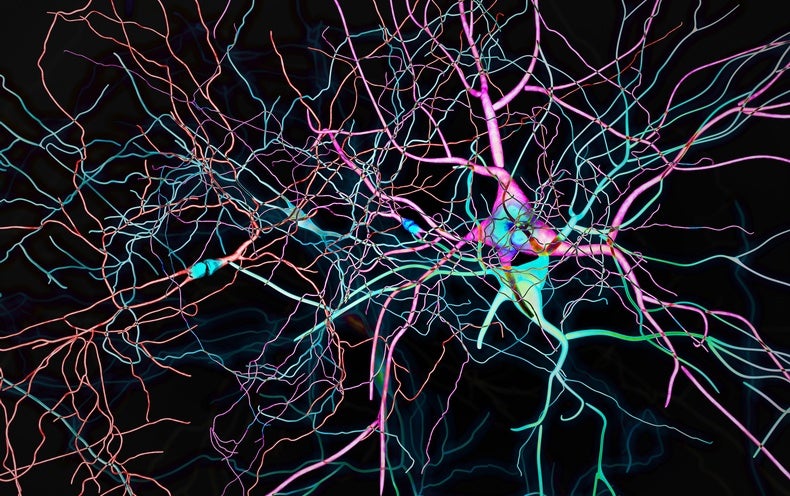Scientists used the linearly arranged cellulose microchannels in asparagus stalks as a biocompatible scaffold for neural stem cell cultures.
The oldest recipe for cooking asparagus is attributed to Marcus Gavius Apicius, an ancient Roman foodie who many culinary historians believe wrote the first cookbook.1 The cardinal rule for preparing perfect asparagus has survived over the ages: don’t overcook it. The difference between soggy stalks and crispy spears is cellulose, the complex carbohydrate that gives plants their structural integrity and breaks down under extreme cooking conditions. In another kitchen of sorts—a research laboratory at the University of Ottawa—Andrew Pelling, a professor of physics and biology, and his multidisciplinary team are cooking up an asparagus recipe for regenerating nerves.
Neural stem cell therapy is a promising strategy for repairing injured nerves following trauma or disease. The success of cell therapy depends on the cell culture conditions, including biocompatible 3D scaffolds that enable cell survival, differentiation, and axon guidance.2 “Years ago, I was cooking asparagus at home. I looked at the ends and noticed all these channels. There had been a ton of work already in bioengineering scaffolds with channels and I wondered whether this could be a viable approach,” Pelling said.
See More “Apples Lay the Foundation for Regenerating Bone“

Nerve cell axons grow in bundles and require various chemical and physical cues to guide their regeneration after injury.
These bundled microchannels help transport water and nutrients along the length of the asparagus spears.3 Their linear arrangement makes them an intriguing, repurposed biomaterial for regenerating nerves, whose normal architecture consists of linear axon bundles. Because cells tend to track along linear structures in a process called contact guidance,4 channels encourage cells to align and migrate within their inner and outer surfaces. Pelling thought that the naturally occurring cellulose channels in asparagus could be applied to tissue engineering strategies to help bridge the damaged ends of severed spinal cords or peripheral nerves.
“Its an interesting approach using plant-based materials. They would be very affordable and easy to source,” said Dosh Whye, assistant director of Cell Development and Differentiation at Harvard Medical School’s Human Neuron Core, who was not involved in this study. “Bioengineering devices that can reflect [native] tissue scaffolding and integration with other cell types would be a wonderful thing.”
We go to the grocery store, buy some asparagus, and use a biopsy punch to [create] cylinders of asparagus tissue.
– Andrew Pelling, University of Ottawa
In a recent preprint study, Pelling’s team described how they used these naturally occurring asparagus channels to create a 3D scaffold for growing neural stem cells in vitro.5 “We go to the grocery store, buy some asparagus, and use a biopsy punch to [create] cylinders of asparagus tissue,” Pelling described. His team used detergents to chemically remove the asparagus plant cells, proteins, and DNA, leaving behind the supportive cellulose microchannel structure. They loaded neural stem cells onto these structures and tracked their behavior over time. Pelling’s team found that the asparagus cellulose scaffold enabled attachment, proliferation, and differentiation of cultured neural stem cells, making it a promising biocompatible option for future neural stem cell therapies.
See More “Making Scientific Strides in the Produce Aisle“
Pelling draws some parallels between culinary and laboratory skills. “A lot of cooking becomes instinctual. With experience, you get a sense of what will work and what won’t work. The more time you spend in a lab, the more your intuition is honed and that makes a better scientist at the end of the day—the experience of making mistakes and gaining wisdom is the key.”
References:
- Project Gutenberg’s Cooking and Dining in Imperial Rome, by Apicius. Accessed September 26, 2023. https://www.gutenberg.org/files/29728/29728-h/29728-h.htm#transcrip_01
- Tejeda G, et al. Biomaterial strategies to bolster neural stem cell-mediated repair of the central nervous system. Cells Tissues Organs. 2022;211(6):655-669.
- Heyes JA, Clark CJ. Magnetic resonance imaging of water movement through asparagus. Funct Plant Biol. 2003;30(11):1089-1095.
- Provenzano PP, et al. Engineering three-dimensional collagen matrices to provide contact guidance during 3D cell migration. Curr Protoc Cell Biol. 2010;Chapter 10:Unit-10.17.
- Couvrette L, et al. Plant cellulose as a substrate for 3D neural stem cell culture. bioRxiv. 2023; 2023-06.














